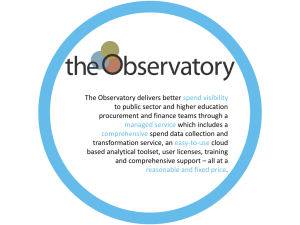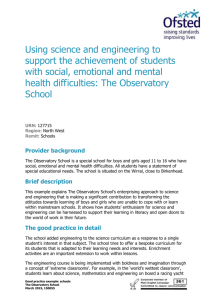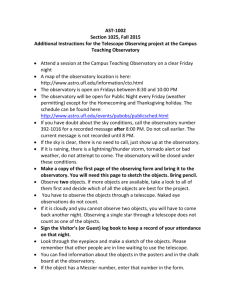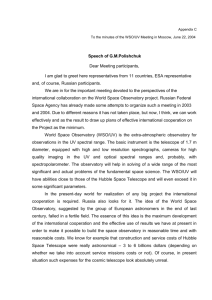Press Release in MS Doc - WM Keck Observatory
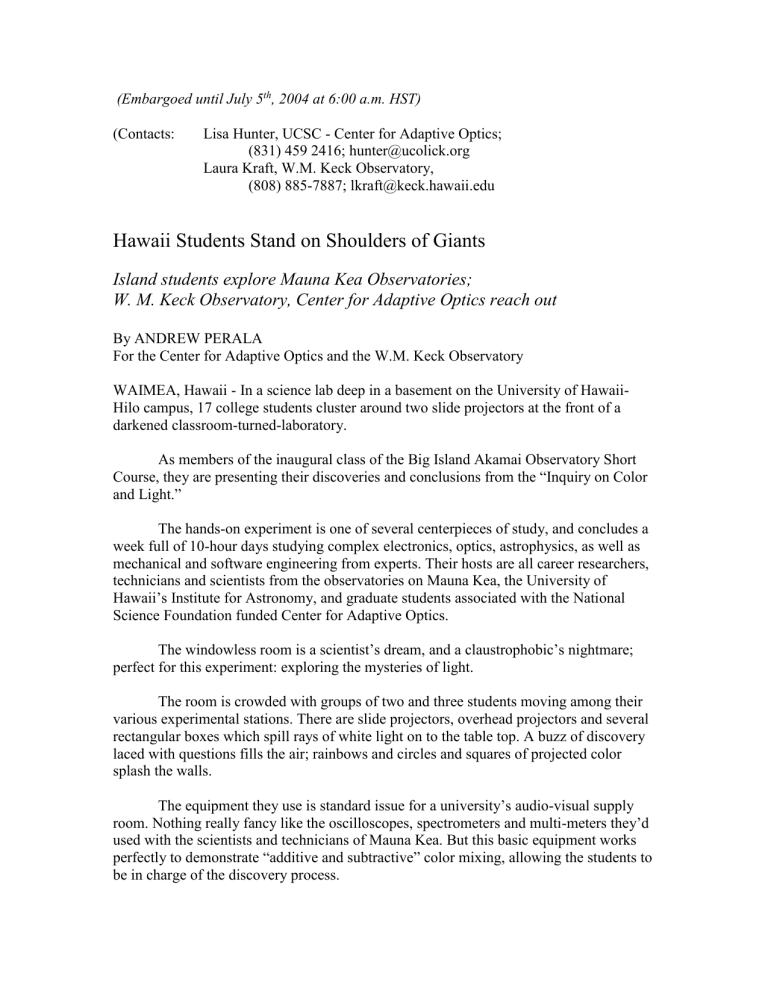
(Embargoed until July 5 th
, 2004 at 6:00 a.m. HST)
(Contacts: Lisa Hunter, UCSC - Center for Adaptive Optics;
(831) 459 2416; hunter@ucolick.org
Laura Kraft, W.M. Keck Observatory,
(808) 885-7887; lkraft@keck.hawaii.edu
Hawaii Students Stand on Shoulders of Giants
Island students explore Mauna Kea Observatories;
W. M. Keck Observatory, Center for Adaptive Optics reach out
By ANDREW PERALA
For the Center for Adaptive Optics and the W.M. Keck Observatory
WAIMEA, Hawaii - In a science lab deep in a basement on the University of Hawaii-
Hilo campus, 17 college students cluster around two slide projectors at the front of a darkened classroom-turned-laboratory.
As members of the inaugural class of the Big Island Akamai Observatory Short
Course, they are presenting their discoveries and conclusions from the “Inquiry on Color and Light.”
The hands-on experiment is one of several centerpieces of study, and concludes a week full of 10-hour days studying complex electronics, optics, astrophysics, as well as mechanical and software engineering from experts. Their hosts are all career researchers, technicians and scientists from the observatories on Mauna Kea, the University of
Hawaii’s Institute for Astronomy, and graduate students associated with the National
Science Foundation funded Center for Adaptive Optics.
The windowless room is a scientist’s dream, and a claustrophobic’s nightmare; perfect for this experiment: exploring the mysteries of light.
The room is crowded with groups of two and three students moving among their various experimental stations. There are slide projectors, overhead projectors and several rectangular boxes which spill rays of white light on to the table top. A buzz of discovery laced with questions fills the air; rainbows and circles and squares of projected color splash the walls.
The equipment they use is standard issue for a university’s audio-visual supply room. Nothing really fancy like the oscilloscopes, spectrometers and multi-meters they’d used with the scientists and technicians of Mauna Kea. But this basic equipment works perfectly to demonstrate “additive and subtractive” color mixing, allowing the students to be in charge of the discovery process.
The students are, in the words of Isaac Newton, “Standing on the shoulders of giants who preceded them in discovery.”
Funded by the Center for Adaptive Optics and co-sponsored by the W. M. Keck
Observatory, the Akamai Observatory Short Course is an annual outreach program inaugurated May 31-June 4, 2004, in Waimea and Hilo.
W. M. Keck Observatory Astronomer Dr. David Le Mignant and colleague Sarah
Anderson worked with the CfAO Education and Human Resources team of Lisa Hunter,
Malika Moutawakkil and Gale Kihoi to coordinate the Hawaii Island activities of the
Akamai Observatory Short Course. The course was provided cost free to the students.
Astronomy graduate students Patrik Jonsson and Michael McElwain, and Professor
Claire Max, all from the Center for Adaptive Optics, were the primary teachers for the course.
Other instructors included staff from the Canada-France-Hawaii, Gemini, Keck and Submillimeter Array observatories who donated their time and expertise to teach.
Their volunteer work represented the best offerings from the hundreds of scientists, researchers, technicians and other support staff who keep the state’s annual $150 million astronomy industry humming.
The group spent two days in Waimea and two days in Hilo, with the high point taking place on Wednesday at the summit of Mauna Kea. The students toured four facilities, stayed for sunset, and enjoyed the rise of a very full moon.
Prior to their visit, the students listened to Kepa Maly, historian and resource specialist, about the cultural significance of Mauna Kea, a sacred place for many and a unique place to be respected by all. As they acclimatized at Hale Pohaku, Kimo Pihana, a Mauna Kea park ranger and
Hawaiian cultural practitioner, “talked story” with the students.
“The Akamai program is introducing the exciting fields of astronomy and engineering to student’s career choices,” said Dr. Claire Max, deputy director of the
Center for Adaptive Optics at the University of California at Santa Cruz.
Sixteen of the seventeen students who participated in the Akamai Observatory
Short Coarse are Hawaii state residents; five are from the University of Hawaii at Hilo, four are attending college on the mainland, three are from Maui Community College and five are from elsewhere in the state who are interested in a potential observatory career.
"We are pleased that we had a high percentage of local students participating. One of our goals is for kids to get personal view of life at observatories," said Sarah Anderson from W. M. Keck Observatory.
During the Akamai course, the emphasis was on interactive learning and discovery, as well as exposing the students to the wide range of skills and people needed to power the world-class research of Mauna Kea’s observatories.
“The Akamai program is designed to be the first step for observatory internship training programs, to give the students a hands-on sense of the full breadth of opportunities available,” Max said.
“It’s exciting to hear from all the different people,” said one student.
“The inquiry project gave me a sense of power over what I wanted to know, and it made me want to know more .
It’s empowering,” said Mari Okami, a Waimea resident and an engineering major in her sophomore year at Columbia University in New York
City.
Various Hawaii Island observatory internship programs, administered by the
Center for Adaptive Optics, CFHT, Gemini North, the Institute for Astronomy, Lawrence
Livermore National Laboratory, the Submillimeter Array or the W. M. Keck
Observatory, will sponsor more than dozen student internships at observatories this summer.
For the past decade, Mauna Kea observatories like Keck and Gemini have been sponsoring both high-school students during the school year and college students during the summer, paying salaries, providing guidance and even helping with performance reviews for the college students.
The trend toward offering more opportunities to students, especially to students from under-represented groups in science, is strong and growing stronger among the
Mauna Kea observatories, said Le Mignant.
“That’s the beauty of the Akamai course,” he said. “It gives students the opportunity to learn the basics of the highly-technical skills and concepts used daily at the astronomical observatories. Perhaps for the first time they understand the range of skills needed and realize they can master them.”
“This course is extremely helpful in learning about the observatories in a way that
I never knew before,” said another student.
“We hope to enlist participation from even more observatories in future years,” said Lisa Hunter of the Center for Adaptive Optics. “Internships provide students with the skills, motivation, and mentors needed to be successful in scientific and technical careers.
The Akamai short course brings together the observatories and gets local students ready for a successful internship experience. By pooling our resources more students can get involved.”
“We all need to do more,” Max said. “We all have a responsibility to increase opportunities in science and engineering careers for the young people of Hawaii. This new course is a great first step.”
“If you have the talent, the will, and can be allowed the chance to succeed, any person from any background can achieve success in astronomy or engineering,” said Dr.
Jerry Nelson, director of the Center for Adaptive Optics, a co-sponsor of the Akamai project.
“This short course literally opened my wings and allowed me to reach for the stars,” said student Noah Luis.
1,186 words

